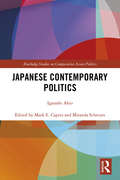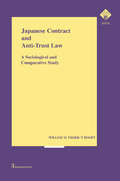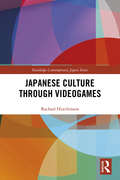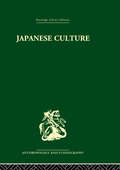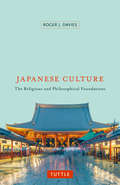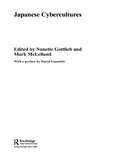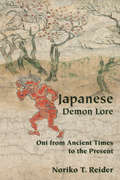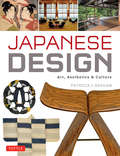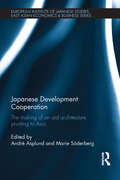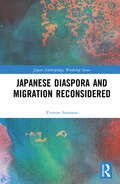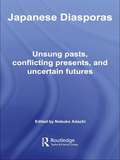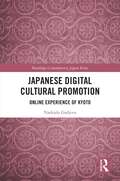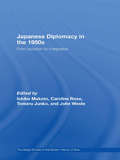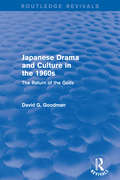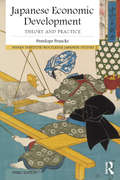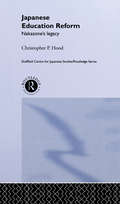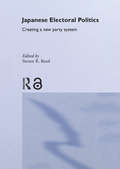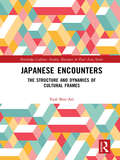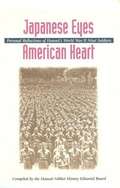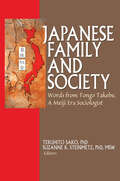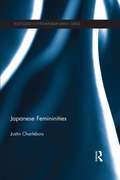- Table View
- List View
Japanese Contemporary Politics (Routledge Studies on Comparative Asian Politics)
by Akio IgarashiIn the postwar period, Japanese politics has evolved considerably, with issues of gender, representation, and household economics becoming increasingly salient. Meanwhile, since the end of the Cold War, Japan has joined other developed states in the process of decentralization and deindustrialization. Yet, its restructuring has come at a slower pace, as the Japanese bureaucracy attempts to retain a more traditional approach. This book, a translated and updated version of the author's 2010 monograph Nihon seijiron, traces these developments in Japanese politics from the end of the Asia Pacific wars to the present day. Examining each of the key stages of transition, it looks at four aspects of Japanese politics: high politics, interest-centered politics, life-centered politics, and globalization. It also provides up-to-date analysis of contemporary themes, including the Abe administration’s challenge to international politics and coverage of nuclear issues. Written by an experienced Japanese scholar, this book ultimately demonstrates how globalization has transformed the nature of local politics, as well as national security. However, as seen in the recent triple disaster of 2011 (a chapter on which has been added), Japanese politics retains traditional practices that have led to corruption, scandal, and political mistrust among the electorate. Offering a comprehensive introduction to Japanese politics, this book will be invaluable reading for students and scholars of Japanese politics and comparative and Asia politics in general.
Japanese Contract and Anti-Trust Law: A Sociological and Comparative Study
by Willem Visser t'HooftLittle has been written on Japanese contract law and anti-trust law in Western languages. This book describes the role of this law in protecting the distributor against unilateral terminations of distribution agreements. There have been significant pressures both to lower prices and restructure distribution channels in Japan which have strained many distribution agreements. This volume, based primarily on Japanese language legal material, not only involves a study of applicable black-letter law, but also a sociological study of its application in practice. Detailed analysis has been made in particular of famous legal termination cases during the 1990s in the Japanese luxury cosmetics distribution system which generated influential decisions by the higher courts and the Fair Trade Commission, providing new insights into whether or not there are distinct Japanese attitudes towards contracts.
Japanese Culture Through Videogames (Routledge Contemporary Japan Series)
by Rachael HutchinsonExamining a wide range of Japanese videogames, including arcade fighting games, PC-based strategy games and console JRPGs, this book assesses their cultural significance and shows how gameplay and context can be analyzed together to understand videogames as a dynamic mode of artistic expression. Well-known titles such as Final Fantasy, Metal Gear Solid, Street Fighter and Katamari Damacy are evaluated in detail, showing how ideology and critique are conveyed through game narrative and character design as well as user interface, cabinet art, and peripherals. This book also considers how ‘Japan’ has been packaged for domestic and overseas consumers, and how Japanese designers have used the medium to express ideas about home and nation, nuclear energy, war and historical memory, social breakdown and bioethics. Placing each title in its historical context, Hutchinson ultimately shows that videogames are a relatively recent but significant site where cultural identity is played out in modern Japan. Comparing Japanese videogames with their American counterparts, as well as other media forms, such as film, manga and anime, Japanese Culture Through Videogames will be useful to students and scholars of Japanese culture and society, as well as Game Studies, Media Studies and Japanese Studies more generally.
Japanese Culture: Its Development and Characteristics
by Robert J Smith Richard K BeardsleyThis book presents an authoritative and illuminating insight into the development and most important characteristics of Japanese society and culture. Approaching the subject from a number of different points of view. Originally published in 1963.
Japanese Culture: The Religious and Philosophical Foundations
by Roger J. DaviesJapanese Culture: The Religious and Philosophical Foundations takes readers on a detailed and thoroughly researched journey through Japan's cultural history.This much-anticipated sequel to Roger Davies's best-selling The Japanese Mind provides a comprehensive overview of the religion and philosophy of Japan. This cultural history of Japan explains the diverse cultural traditions that underlie modern Japan and offers readers deep insights into Japanese manners and etiquette. Davies begins with an investigation of the origins of the Japanese, followed by an analysis of the most important approaches used by scholars to describe the essential elements of Japanese culture. From there, each chapter focuses on one of the formative elements: Shintoism, Buddhism, Taoism, Zen, Confucianism, and Western influences in the modern era.Davies concludes each chapter with extensive endnotes along with thought-provoking discussion activities, making this volume ideal for individual readers and for classroom instruction. Anyone interested in pursuing a deeper understanding of this complex and fascinating nation will find Davies's work an invaluable resource.
Japanese Cybercultures (Asia's Transformations/Asia.com)
by Nanette Gottlieb Mark McLellandJapan is rightly regarded as one of the most technologically advanced countries in the world, yet the development and deployment of Internet technology in Japan has taken a different trajectory compared with Western nations. This is the first book to look at the specific dynamics of Japanese Internet use. It examines the crucial questions:* how the Japanese are using the Internet: from the prevalence of access via portable devices, to the fashion culture of mobile phones* how Japan's "cute culture" has colonized cyberspace* the role of the Internet in different musical subcultures* how different men's and women's groups have embraced technology to highlight problems of harassment and bullying* the social, cultural and political impacts of the Internet on Japanese society* how marginalized groups in Japanese society - gay men, those living with AIDS, members of new religious groups and Japan's hereditary sub-caste, the Burakumin - are challenging the mainstream by using the Internet.Examined from a variety of interdisciplinary perspectives, using a broad range of case-studies, this is an exciting and genuinely cutting-edge book which breaks new ground in Japanese studies and will be of value to anyone interested in Japanese culture, the Internet and cyberculture.
Japanese Demon Lore: Oni from Ancient Times to the Present
by Noriko ReiderOni, ubiquitous supernatural figures in Japanese literature, lore, art, and religion, usually appear as demons or ogres. Characteristically threatening, monstrous creatures with ugly features and fearful habits, including cannibalism, they also can be harbingers of prosperity, beautiful and sexual, and especially in modern contexts, even cute and lovable. There has been much ambiguity in their character and identity over their long history. Usually male, their female manifestations convey distinctivly gendered social and cultural meanings. Oni appear frequently in various arts and media, from Noh theater and picture scrolls to modern fiction and political propaganda, They remain common figures in popular Japanese anime, manga, and film and are becoming embedded in American and international popular culture through such media. Noriko Reiderýs book is the first in English devoted to oni. Reider fully examines their cultural history, multifaceted roles, and complex significance as "others" to the Japanese.
Japanese Design
by Patricia J. GrahamWhat exactly is the singular attraction of Japanese design? And why does it speak so clearly to so many people all over the world? The Japanese sensibility often possesses an intuitive, emotional appeal, whether it's a silk kimono, a carefully raked garden path, an architectural marvel, a teapot, or a contemporary work of art. This allure has come to permeate the entire culture of Japan-it is manifest in the most mundane utensil and snack food packaging, as well as in Japanese architecture, and fine art. In Japanese Design, Asian art expert and author Patricia J. Graham explains how this aesthetic based in fine craftsmanship and simplicity developed. Her unusual, full-color presentation reveals the Japanese design aesthetic in an absorbing way, using a combination of insightful explanations and more than 160 stunning photos. Focusing upon ten elements of Japanese design, Graham explores how visual qualities, the cultural parameters and the Japanese religious traditions of Buddhism and Shinto have impacted the appearance of its arts. Japanese Design is a handbook for the millions of us who have felt the special allure of Japanese culture, crafts, and art. Art and design fans and professionals have been clamoring for this-a book that fills the need for an intelligent, culture-rich overview of what Japanese design is and means.
Japanese Design
by Patricia J. GrahamWhat exactly is the singular attraction of Japanese design? And why does it speak so clearly to so many people all over the world? The Japanese sensibility often possesses an intuitive, emotional appeal, whether it's a silk kimono, a carefully raked garden path, an architectural marvel, a teapot, or a contemporary work of art. This allure has come to permeate the entire culture of Japan-it is manifest in the most mundane utensil and snack food packaging, as well as in Japanese architecture, and fine art.In Japanese Design, Asian art expert and author Patricia J. Graham explains how this aesthetic based in fine craftsmanship and simplicity developed. Her unusual, full-color presentation reveals the Japanese design aesthetic in an absorbing way, using a combination of insightful explanations and more than 160 stunning photos. Focusing upon ten elements of Japanese design, Graham explores how visual qualities, the cultural parameters and the Japanese religious traditions of Buddhism and Shinto have impacted the appearance of its arts.Japanese Design is a handbook for the millions of us who have felt the special allure of Japanese culture, crafts, and art. Art and design fans and professionals have been clamoring for this-a book that fills the need for an intelligent, culture-rich overview of what Japanese design is and means.
Japanese Design
by Patricia J. GrahamWhat exactly is the singular attraction of Japanese design? And why does it speak so clearly to so many people all over the world? The Japanese sensibility often possesses an intuitive, emotional appeal, whether it's a silk kimono, a carefully raked garden path, an architectural marvel, a teapot, or a contemporary work of art. This allure has come to permeate the entire culture of Japan-it is manifest in the most mundane utensil and snack food packaging, as well as in Japanese architecture, and fine art.In Japanese Design, Asian art expert and author Patricia J. Graham explains how this aesthetic based in fine craftsmanship and simplicity developed. Her unusual, full-color presentation reveals the Japanese design aesthetic in an absorbing way, using a combination of insightful explanations and more than 160 stunning photos. Focusing upon ten elements of Japanese design, Graham explores how visual qualities, the cultural parameters and the Japanese religious traditions of Buddhism and Shinto have impacted the appearance of its arts.Japanese Design is a handbook for the millions of us who have felt the special allure of Japanese culture, crafts, and art. Art and design fans and professionals have been clamoring for this-a book that fills the need for an intelligent, culture-rich overview of what Japanese design is and means.
Japanese Development Cooperation: The Making of an Aid Architecture Pivoting to Asia (European Institute of Japanese Studies East Asian Economics and Business Series)
by André Asplund Marie SoderbergThe world order as we know it is currently undergoing profound changes, and in its wake, so is foreign aid. Donors of foreign aid, development assistance or development cooperation around the world are already facing new challenges in the changing development architecture. This is an architecture that globally seems to become increasingly forgiving of foreign aid as a win-win concept that also meets the donors’ own national interests—something that has been an unofficial Japanese trademark for many years. This book examines Japan’s development assistance as it transitions away from Official Development Assistance and towards Development Cooperation. In this transition, the strong and reciprocal relationships between Japanese development policy and comprehensive security, diplomacy, foreign, domestic and economic policies are likely to become even more consolidated and integrated. The utilization of, and changes within, Japanese development policy therefore affects not only recipients of foreign aid but also the relationships Japan enjoys with its allies and strategic partners, as well as the relations to competing donors and rivals in the region and around the world. Japanese foreign aid as such provides an extremely interesting case from where regional and even global changes can be understood. Written by a multidisciplinary team of contributors from the fields of political science, international relations, development, economics, public opinion and Japan studies, the book sets out to be innovative in capturing the essence of the changing patterns of development cooperation, and more importantly, Japan’s role in within it, in an era of great change. This book will be of great interest to students and scholars of Japanese Politics, Foreign Policy and International Relations.
Japanese Diaspora and Migration Reconsidered (Japan Anthropology Workshop Series)
by Yvonne SiemannIn contrast to most studies of migration, which assume that migrants arrive from less developed countries to the industrialised world, where they suffer from discrimination, poor living conditions and downward social mobility, this book examines a different sort of diaspora – descendants of Japanese migrants or "Nikkei" – in Bolivia, who, after a history of organised migration, have achieved middle-class status in a developing country, while enjoying much symbolic capital among the majority population. Based on extensive original research, the book considers the everyday lives of Nikkei and their identity, discusses how despite their relative success they remain not fully integrated into Bolivia's imperfect pluricultural society and explores how they think about, and relate to, Japan.
Japanese Diasporas: Unsung Pasts, Conflicting Presents and Uncertain Futures (Routledge Studies in Asia's Transformations #7)
by Nobuko AdachiJapanese Diasporas examines the relationship of overseas Japanese and their descendents (Nikkei) with their home and host nations, focusing on the political, social and economic struggles of Nikkei. Frequently abandoned by their homeland, and experiencing alienation in their host nations, the diaspora have attempted to carve out lives between two worlds. Examining Nikkei communities and Japanese migration to Manchuria, China, Canada, the Philippines, Singapore and Latin America, the book compares Nikkei experiences with those of Japanese transnational migrants living abroad. The authors connect theoretical issues of ethnic identity with the Japanese and Nikkei cases, analyzing the hidden dynamics of the social construction of race, ethnicity and homeland, and suggesting some of the ways in which diasporas are transforming global society today. Presenting new perspectives on socio-political and cultural issues of transnational migrants and diaspora communities in an economically intertwined world, this book will be of great interest to scholars of diaspora studies and Japanese studies.
Japanese Digital Cultural Promotion: Online Experience of Kyoto (Routledge Contemporary Japan Series)
by Nadejda GadjevaGadjeva uses Kyoto as a case study to explore the innovative mechanisms being used to promote Japanese culture and cultural properties since the outbreak of COVID-19. Beginning by setting out the main initiatives and actors involved in preserving, introducing and utilising Kyoto’s cultural heritage, Gadjeva proceeds to discuss alternative approaches using digital technologies. These tools include remote access immersive reality, virtual reality, augmented reality, augmented virtuality, and mixed reality. She looks at how such approaches have been applied to Kyoto’s digital museums, real-time online experiences, and other virtual projects presenting tangible, intangible, and folk heritage. In doing so she draws on a wide range of interviews with experts from the Japan Foundation, the Kyoto Art Center, and other related institutions to investigate the limitations and possible strategies for further development of these practices. She also interviews scholars, government officials and experts from Europe about the prospects for further remote online experiences, applied both specifically to Kyoto and more broadly to cultural tourism. Based on the findings, the book discusses particular future challenges and suggests specific policies and project proposals for further remote online experiences of Kyoto’s cultural properties. A valuable read for professionals and scholars of cultural and tourism studies, that will be of particular interest to those specialising in Japan.
Japanese Diplomacy in the 1950s: From Isolation to Integration (Routledge Studies in the Modern History of Asia)
by Caroline Rose Iokibe Makoto Tomaru Junko John WesteThis book provides a detailed examination of Japan's diplomatic relations in the 1950s, an important decade in international affairs when new structures and systems emerged, and when Japan established patterns in its international relationships which continue today. It examines the process of Japan's attempts to rehabilitate itself and reintegrate into a changing world, and the degree of success to which Japan achieved its goals in the political, economic and security spheres. The book is divided into three parts, each containing three chapters: Part I looks at Japan in the eyes of the Anglo-American powers; Part II at Japanese efforts to gain membership of newly forming regional and international organizations; and Part III considers the role of domestic factors in Japanese foreign policy making. Important issues are considered including Japanese rearmament and the struggle to gain entry into the United Nations. In contrast to much of the academic literature on post-war Japanese diplomacy, generally presenting Japan as a passive actor of little relevance or importance, this book shows that Japan did not simply sit passively by, but formed and attempted to instigate its own visions into the evolving regional and global structures. It also shows that whilst Japan did not always figure as highly as its politicians and policy makers may have liked in the foreign policy considerations of other nation states, many countries and organizations did attach a great deal of importance to re-building relations with Japan throughout this period of re-adjustment and transformation.
Japanese Drama and Culture in the 1960s: The Return of the Gods (Routledge Revivals)
by D.G. GoodmanThis title was first published in 1988: In this book the author has translated five postwar experimental Japanese plays and recreated the artistic, social and spiritual milieu in which they were created. He describes the turning point in Japanese thinking about the nature and limitations of a Western-oriented modern culture, and the creation of "underground" theatres which in which evolved a new mythology of history. Professor Goodman sees these developments as an interplay between personal and political (ie revolutionary) salvation.
Japanese Economic Development: Theory and practice (Nissan Institute/Routledge Japanese Studies)
by Penny FrancksThis fully revised and updated third edition of Japanese Economic Development looks at Japan's economic history from the nineteenth century through to World War II, recasting analysis of Japan’s economic past in the light fresh theoretical perspectives in the study of economic history and development. Francks draws out the historical roots of the institutions and practices on which Japan's post-war economic miracle was based and provides a comparative framework within which the Japanese case can be understood and related to development in the rest of the world. New features for this edition include: textboxes summarising key concepts expanded coverage of the early-modern economy, the ‘traditional sector’, and the international context of Japanese growth an increased number of case studies fully up-dated references, glossary and bibliography. Taking a thematic approach, this textbook demonstrates how studying the first example of Asian industrialisation can provide the basis for an alternative, non-western narrative of development. As it such is an important resource for undergraduate and postgraduate courses on the Japanese economy, as well as comparative economic development and economic history more generally.
Japanese Education Reform: Nakasone's Legacy (The University of Sheffield/Routledge Japanese Studies Series)
by Christopher P. HoodThe Japanese education system has attracted increasing attention over the past 20 years, largely due to the belief that it has been central to Japan's economic growth. Many have felt, however that the system is stunted by an inability, or perhaps even on an incapacity, to change. This study challenges these contentions. It examines the reform policies implemented by Prime Minister Nakasone during the 1980s and argues that, not only has the system changed considerably as a result of Nakasone's work, but that it continues to do so. It analyses the key areas of the education reform debate, in particular internationalism, government control of education, increased liberalization and various social problems, and considers the degree to which response to them have been successful. This book will be of great interest to all those interested in the Japanese educational system.
Japanese Electoral Politics: Creating a New Party System (Nissan Institute/Routledge Japanese Studies)
by Steven R. ReedThe old Japanese single-party system collapsed in 1993, but a new system has not yet fully evolved. Following the most significant party reform in Japanese history, this book analyses the most recent national elections, examining voter behaviour and how it is influenced. It provides a comprehensive overview of Japanese politics from 1955 to 1993 and a detailed historical study of events leading up to the 1996 and 2000 elections, before presenting statistical analysis of the elections themselves. The authors then look to the future, anticipating what form the new political system will take. Japanese Electoral Politics contains four very detailed case studies and a wealth of new data. It will appeal to students and researchers of Japanese politics and elections and electoral systems.
Japanese Encounters: The Structure and Dynamics of Cultural Frames (Routledge Culture, Society, Business in East Asia Series)
by Eyal Ben-AriThis book explores the multiplicity of special times and spaces in Japan within which people get together to decide, celebrate or play, in gatherings such as organizational meetings, community festivities, preschool games or drinking bouts. It analyzes these gatherings in relation to the theoretical model of sociocultural frames, examining how such occasions are put together, their unfolding stages, interactive encounters, and relations between participants and the wider social and cultural contexts. It considers the cognitive, emotional and behavioural dimensions, the scope for manipulation and the effects, intentional and unintentional, on participants and the connections to the ways in which in society and culture change. Overall, besides describing specific rites and ceremonies in Japan, the book provides great insights into the process whereby the interactions, feelings and action of individuals and groups shape popular culture.
Japanese Enthronement Ceremonies: With An Account Of The Imperial Regalia (classic Reprint) (The\kegan Paul Japan Library #No. 2)
by HoltomFirst Published in 1996. Routledge is an imprint of Taylor & Francis, an informa company.
Japanese Eyes American Heart: Personal Reflections of Hawaii's World War II Nisei Soldiers
by Hawaii Nikkei History Editorial Board Tendai Education Foundation StaffJapan's attack on Pearl Harbor on December 7, 1941, set Hawaii on a new course of history that would affect every living soul in these Islands. How Hawaii's people, particularly those of Japanese ancestry, responded to the act of aggression by Japan changed Hawaii's social, economic, and political history forever. Much has been written about how Americans of Japanese ancestry (AJA) in the 100th Infantry Battalion, 442nd Regimental Combat Team, Military Intelligence Service, and the 1399th Engineer Construction Battalion answered their country's call through military service--and the high price they paid in human lives in freedom's cause. The history has been recorded, the battles documented, the medals tallied, the social and political legacy articulated and applauded. Not as thoroughly recorded, however, are the thoughts and innermost feelings of the nisei soldiers who put their lives on the line for their country, and what those experiences meant to them. Those stories have always been the most difficult to pry from the hearts and souls of the AJA men who served our country in World War II. It was that void in the story of Hawaii's nisei soldiers that Bishop Ryokan Ara of the Tendai Educational Foundation asked members of the Hawaii Nikkei History Editorial Board to fill. Japanese Eyes... American Heart is the result of that effort. It is a rare and powerful collection of personal thoughts written by the soldiers themselves, reflections of the men's thoughts as recorded in diaries and letters sent home to family members and friends, and other expressions about an episode that marked a turning point in the lives of many.
Japanese Family and Society: Words from Tongo Takebe, A Meiji Era Sociologist
by Phil BarkerAn accurate, thought provoking translation of original work from sociologist pioneer Tongo TakebeToday's sociology education emphasizes multiculturalism, yet most of the views originate from Judeo-Christian perspectives that can limit insight and understanding. Japanese Family and Society: Words from Tongo Takebe, A Meiji Era Sociologis
Japanese Femininities (Routledge Contemporary Japan Series)
by Justin CharleboisThe corporate salaryman and professional housewife stand as hegemonic archetypes of masculinity and femininity in Japan. However, these rigid gender roles are being challenged by women who are seeking to move beyond the strictly defined confines of their traditional roles as caregivers and homemakers. Through interviews with a range of Japanese women, this book explores how women’s gender roles are both reified and undermined in Japan today, and uncovers the prevalent themes, or ‘discourses’, that are utilized to construct gendered identities. It shows that while dominant discourses formulate notions of femininity within the domestic sphere, these are simultaneously resisted and problematized by contemporary women. To this end, Justin Charlebois traces the construction of different ‘oppositional’ femininities, such as the single career woman and married working mother, which challenge, destabilize, and potentially reconfigure the traditional gender order. This book makes an important contribution to our understanding of gender roles and femininity in Japan, and as such will be of great interest to students and scholars of Japanese culture and society, gender studies and women's studies.
